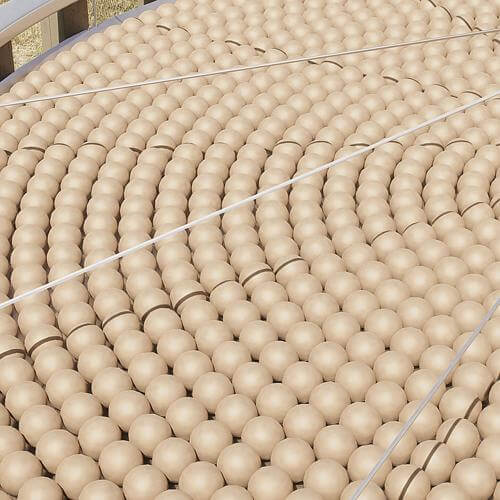CHEYENNE — Another company has announced intentions to capture carbon dioxide directly from the air and inject it for permanent storage in underground geologic formations in Wyoming. Direct air capture (DAC) is a relatively new technology that has been criticized for being inefficient and expensive. But San Francisco-based Spiritus, which announced its plans for a “Carbon Orchard” on Tuesday, said its will be different.

White orbs the size of a tennis ball are positioned in the open air. They are filled with a material, called a sorbent, that acts as a sponge that passively absorbs carbon dioxide from the air over a few hours. The sorbents are then transported back into the main capsule, which Spiritus calls a “tree,” to remove the CO2 so that it can be transported and injected underground. This removal is done by heating to less than 212 degrees Fahrenheit. The “fruit,” which Spiritus calls the sorbent units, are then transported back to the outside of the tree on a conveyor belt to repeat the process. The technology was developed by scientists at Los Alamos National Lab.
The project, called Orchard One, will be in central Wyoming, and is expected to send 2 million tons of CO2 underground every year.
Currently, this process costs between $600 and $1,000 to remove one ton of CO2 from the atmosphere. Spiritus, along with a handful of other DAC startups, claims they will reduce that cost to below $100, making DAC a more affordable and efficient technology to address the climate crisis.
Is it efficient?

Some DAC companies estimate it takes between 2,000 and 2,400 kilowatt-hours of energy to capture one ton of CO2, equivalent to about a fifth of the average U.S. home’s annual energy consumption.
Producing 2,400 kilowatt-hours of energy currently emits about one ton of CO2 into the atmosphere, meaning some current DAC projects are expensive, carbon-neutral investments at best, unless it relies on renewable energies.
Spiritus co-founder and CEO Charles Cadieu said the cost of its sorbent is one-tenth the cost of other DAC sorbents, it will use less than half the energy of what others use, and construction of its facilities will be one-quarter of the cost of existing DAC facilities.
He also said he wants the facility to run solely on renewable energies, such as wind and solar, specifically leaning into curtailed energy — excess renewable energy that is not delivered to customers.
If the cost estimates are true and the energy goals realized, Orchard One may be a truly carbon-negative and affordable facility.
Is it affordable?

According to the company’s application for funding from Frontier, Spiritus estimated that it can eventually reach a capture rate below $75 per ton of CO2. The true numbers from the company’s testing have yet to be publicly released, but Cadieu said he is confident they can meet their goals.
“We’ve gone through extensive diligence with Frontier … which is a group of buyers of Google, McKinsey, JP Morgan, Stripe, Shopify, and they employ experts in this area of direct air capture, and they put us through the wringer. We’re validating the technology and seeing how it stacks up,” he said.
Corporations and businesses may purchase carbon credits from Spiritus to remove carbon on their behalf. Even though the company may be based anywhere in the world, they can count the credits toward their net-zero emission goals.
“With carbon removal using direct air capture, anyone that emits anywhere on Earth that has a problem with getting to net-zero, we … can remove the CO2 for them in Wyoming, and they can then pay us to do that for that facility in Wyoming. So, a local project here is going to have global impact and a global customer base.”
Existing carbon pre-purchase customers include Frontier (founded by Stripe, Alphabet, Shopify, Meta and McKinsey), Watershed and individual citizens via Terraset.
Spiritus will also receive funds from the government through tax credits under Section 45Q. For DAC, companies may receive $180 for every ton of CO2 captured and stored in the ground. Once fully operational, the facility will sequester two megatons, or two million tons, of CO2 every year.
Two megatons of CO2 is equivalent to the emissions of 340,000 pickup trucks annually. However, scientists estimate that up to 10 billion tons of CO2 will need to be removed annually from the atmosphere by 2050 to meet global net-zero emission goals.
Of course, DAC is not the only technology to contribute to carbon removal. There is also carbon capture, utilization and storage, and natural removal through reforestation. In the International Energy Agency’s net-zero emissions by 2050 scenario, DAC technologies must capture more than 85 million tons of CO2 by 2030 and around 980 million tons by 2050. This would require a large and accelerated scale-up from about 10,000 tons captured by DAC today. If the price to capture one ton of CO2 is reduced to $100 and remains there, it would take nearly $100 billion worth of investment to meet the 2050 goal.
Why Wyoming?

Supporters of DAC technologies say that investment at a large scale today is necessary to reduce costs and increase efficiency through continued innovation. Wyoming and Gov. Mark Gordon have been some of the nation’s biggest supporters of the technology.
Since August 2023, Gordon has distributed more than $57.6 million in support of eight carbon capture projects across the state. Wyoming is also home to the potentially largest DAC development in the world in Sweetwater County, Project Bison, which announced earlier this month that it has met an $80 million funding round goal.
For Cadieu, the three most attractive factors in Wyoming are the people, the geology and the permitting environment.
“We are looking to heavily leverage local resources, which have extremely strong oil and gas background and labor resources,” said Mindy Ren, head of carbon removal infrastructure for Spiritus. “So, from the skill set perspective, we can translate our skill hours into our project very directly.”
The geology of Wyoming allows ample, safe underground storage for CO2, and the state is one of only three to have primacy over Class VI well permits — meaning it has permission to distribute permits to inject and store CO2 underground, rather than having to go through the federal government.
Spiritus has not yet applied for a Class VI permit, but officials are hopeful they will be approved and operational by 2026.
“We had some early conversation with the state, with the company, etc. All have received a very favorable and supportive feedback and gesture,” Ren said. “So, (we’re) extremely excited about coming to Wyoming.”
Charles Cadieu founded IQ Engines, which was acquired by Yahoo!/Flickr, and Caption Health, which was acquired by GE HealthCare. He has raised over $75 million for startups through leading ventures, like Khosla Ventures, and non-dilutive funders, like the Bill and Melinda Gates Foundation.
Mindy Ren was hired by Spiritus in December. She has a background in infrastructure management and has previously held positions leading onshore and offshore construction for ExxonMobil, managing engineering, procurement and construction for Tesla’s California battery facilities and overseeing the execution strategy and planning efforts for hyper-scale data center projects at Meta.

